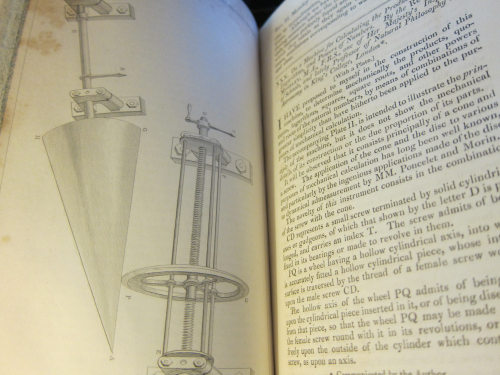JF Ptak Science Books
Moseley, Henry. (1801-1872) “The Rev. H. Moseley on a Machine for Calculating the Products, Quotients, Logarithms,
and Powers of Numbers. (With a Plate.)”, appearing on pp 171-177 in The London, Edinburgh, and Dublin Philosophical
Magazine and Journal of Science, volume XXX, January-June 1847, printed in London by Richard and John F. Taylor.
8vo, vii, 536pp, 4 plates. Bound in half calf, with raised bands; embossed on the covers is the attractive gilt stamp for
the Society of Writers to the Signet. The spine is scuffed and missing one of the two spine labels; the text is fresh and crisp.
Good copy. SOLD
Moseley was a cleric and mathematician, author of a number of books and articles, and at one time professor of natural
philosophy at King's College; he is perhaps best remembered for developing the formula to calculate the stabilities of
war ships (Debus, A.G., World's Who's Who of Science). (Moseley was by the way the father of Henry Nottidge Moseley
and the grandfather of the great Henry G.J. Moseley and the Moseley we most remember (1887-1915).
Moseley writes in the opening paragraphs of this paper proposing the idea of a calculating machine, seemingly (to me ) a 3-D thought experiment, describing in theory how such a machine could work. It is frankly difficult for me to follow, though it is interesting to say the least, especially for 1847. He explains: “I HAVE proposed to myself in the construction of this machine, to determine mechanically the products, quotients, logarithms, squares, square roots, and other powers and roots of the natural numbers, by means of combinations of greater simplicity than have hitherto been applied to the purposes of mechanical calculation.” The design for the instrument looks like a pyramidal funnel with a screw gearworks operating a round wheel on the continuous bolt:
'Some of Moseley's other works include: Lectures on Astronomy, 1839, 4th edit. 1854; the article on 'Definite Integrals' in the Encyclopaedia Metropolitana, 1837; The Mechanical Principles of Engineering and Architecture (, London, 1843, 2nd edit. 1855), 'On the Dynamical Stability and on the Oscillations of Floating Bodies,' read before the Royal Society, 'Philosophical Transactions for 1850 (“One of the most extensively useful results of Moseley's mathematical labours was the publication of the formulas by which the dynamical stabilities of all ships of war have since been calculated. These formulae first appeared in a memoir 'On the Dynamical Stability and on the Oscillations of Floating Bodies"); Syllabus of a Course of Experimental Lectures on the Theory of Equilibrium , London, 1831; A Treatise on Mechanics, applied to the Arts, including Statics and Hydrostatics, 1834 ; 3rd edit. 1847; Illustrations of Mechanics, London, 1839; Theoretical and Practical Papers on Bridges, London, 1843; and some thirty-five papers on natural philosophy.--[Source: Dictionary of National Biography, vol 39, 1885-1900.]
- Full text of the article and the rest of the volume here (via Biodiversity Library:http://biodiversitylibrary.org/item/53520#page/185/mode/1up)
Other works in this volume include some very big names:
*Draper, John W. "On Production of Light by Heat", pp 345-360 ("ALTHOUGH the phaenomenon of the production of
light by all solid bodies, when their temperature is raised to a certain degree, is one of the most familiar in chemistry, no person
so far as I know has hitherto attempted a critical investigation of it."). This may be the most significant paper in this
volume.
Draper, John W. “Mr. J. W. Draper's Remarks on the Existence and Mechanism of the Negative or Protecting Rays of
the Sun”, ...pp 87
Boole, George. “Mr. G. Boole's Remarks on the Rev. B. Bronwin's Method for Differential Equations”, pp 6-8; Boole, George. “Mr. G. Boole's Note on a Class of Differential Equations”, pp. 96-97; Joule, John Prescott. “Mr. J. P. Joule and Dr. Lyon Playfair on the Maximum Density of Water”, pp 41-47; Joule, John Prescott. “Mr. J. P. Joule on the Effects of Magnetism upon the Dimensions of Iron and Steel Bars”,
pp 76-86; Joule, John Prescott. “J. P. Joule on the Effects of Magnetism, &c. upon the Dimensions of Iron and Steel Bars”,
pp 225-241; Airy, G.B. “The Astronomer Royal on Sir David Brewster's New Analysis of Solar Light”, pp 73-76 WITH: “Sir David
Brewster's Reply to the Astronomer Royal on the New Analysis of Solar Light”, pp 153-158; Henry, Joseph. “Prof. J. Henry on the Induction of Atmospheric Electricity on the Wires of the Electric Telegraph”,
pp 186-194; Foucault, Leon and Belfield Lefevre. “On a Method of producing Lights and Shades in equal perfection in
Daguerreotype Pictures, by MM. Belfield Lefevre and Leon Foucault”, pp 213-214; Becquerel, Edmond. “Observations on the Experiments of Messrs. Foucaultand Fizeau, relative to the action of
the Red Rays in Daguerreotype Plates”,pp 214-218; Brewster, David. “On the Knowledge of Distance given by Binocular Vision. (With a Plate.)”, pp 305-318
(delightful!); Hamilton, William Rowan. “On Quaternions ; or on a New System of Imaginaries in Algebra', pp 458-460; Brewster, David. “Sir D. Brewster's Observations on the Analysis of the Spectrum by Absorption”, pp 461-462;





Comments